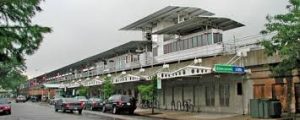Like all things Chicago the history of the Green Line is colorful and “connected”.
The origins of the “L” begin with the privately owned Lake Street Elevated Train Company in 1888 when they received a 25 year franchise contract to construct elevated monorail railroads throughout Chicago.
At the time Michael Cassius McDonald, otherwise known as “King Mike”, controlled much of the city’s gambling and criminal operations. In an effort to gain respect as a legitimate businessman “King Mike” became “manager” of Chicago`s first elevated rail system, the Lake Street Line, which because of “King Mike’s” involvement earned itself the nickname in gambling circles as “Mike`s Upstairs Railroad.“
In 1989, the Lake Street Elevated Train Company began to build, raising the first girder into place at Clinton and Lake Street. By 1890 the company decided to scrap the monorail design in favor of a more traditional and less expensive “cross girder” elevated construction. Construction between Market & Madison and California is completed by 1893 and the first regular passenger service begins with over 50,000 passengers riding the line on the first day of service.
The building of the Green Line continued westward but not without complications. In 1893 the company made it’s first request to franchise, which would have allowed them to extend the Green Line all the way to present day 72nd (present day Harlem Avenue) but negotiations between Cicero Township (present day Oak Park) fell apart. On top of that the company had additional struggles; derailment, equipment replacement and decreased ridership led to increased financial strain causing the sale of the company in 1894 to Charles Tyson Yerkes, another businessman with a questionable reputation. Yerkes immediately injected the badly needed capital into the cash-strapped company and continued negotiations to extend the Lake Street Elevated into Cicero Township (Oak Park). Negotiations between Yerkes and the township were eventually successful, allowing for construction of the Green Line west along South Boulevard to be completed by 1901.
By 1947 private ownership of the “L” was unsustainable and the Chicago Transit Authority (CTA) takes over, implementing major changes to the rail system in 1948, including station closures and efficiency strategies to help simplify operations and cut down on costs.
Fast forward to the 1990’s where poor ridership, skyrocketing costs along with deteriorating structures were serious issues as the Green Line “L” turned 100. Needing a capital infusion the CTA decides to close the entire Green Line for renovation in 1994, reopening for service in late spring of 1996 to a tune of many millions.
How will the Green Line continue to evolve throughout the 21st century? What we do know is that money and technology will play a big factor.
Many thanks to the following sources for providing much needed historical insights: http://www.chicago-l.org/operations/lines/lake.html; http://articles.chicagotribune.com/1988-10-02/features/8802040552_1_gambling-gaming-lake-street-line; http://www.chicago-l.org/history/CTA4.html

